Mohamed Bayoumi
(1894-1963)
"I have toiled at studying cinema, sacrificed my wealth and peace of mind for its sake and fought many battles to preserve it ... My motive has never been materialistic. Cinema, for me, has been a message for which I have endured a great deal of pain."
Mohamed Bayoumi
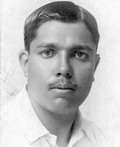
Mohamed Bayoumi
(1894-1963)
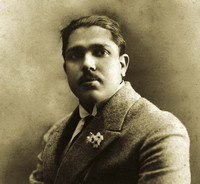
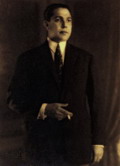
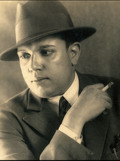
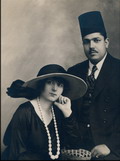
With Charlotte Kralowetz
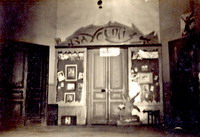
Bayoumi's Studio
on 16, Saad Zaghloul St.
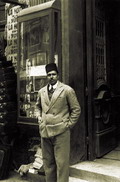
Bayoumi in front of his studio on Saad Zaghloul Street
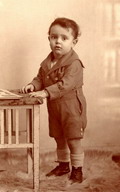
Bayoumi's son, Mohamed Youssef
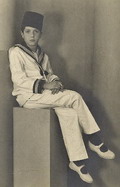
Dawlat Bayoumi
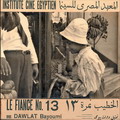
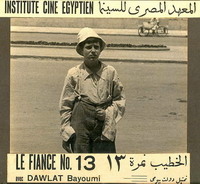
Dawlat, his daughter, in Fiancé Number 13
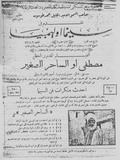
Advert for The Little Magician
Mohamed Bayoumi is the first pioneer of Egyptian cinema as he issued the first newsreel in Egypt, made a self-made camera and established the first cinema institute. He was also the first Egyptian to establish a studio. Sadly enough, this towering figure died in dire poverty without receiving any recognition.
Mohamed Bayoumi was born on 3 January 1894 to a family of cotton merchants in Tanta, a city that lies in the middle of the Egyptian Delta. As a child, he professed genuine interest in a number of extra-curricular activities which clearly foreshadowed his eventual involvement with cinema. For instance, he drew, took photos with an outstanding air of professionalism, and repaired clocks. These embryonic visual and technical talents were to bloom later and drive him into cinematography. They also pinpointed his entrepreneurial spirit, and his independent nature as he used to take photos of his friends in return for money, worked in clock shops to earn his living during summer vacations and started a number of commercial projects during his childhood and early youth.
Another important aspect of his character started to formulate as early as 1911 when at the age of 17 he was to join the youth of the National Party. This early encounter with politics nurtured his nationalism and fostered his dissatisfaction with the British occupation of Egypt, an attitude which was to colour all his actions later in life.
Bayoumi was to finish his primary education at the age of 17, an unusually advanced age for this educational level because his diverse artistic, commercial and political interests had consumed much of his time and energy. He started his secondary education in October 1911 but abruptly shifted to military education in October 1912.
After graduating from military school, he served as an officer in the Egyptian army in the Sudan and Palestine, but was eventually made a reservist on 19 April 1918 because of his refusal to give in to the orders of the British officers, an attitude which can be easily understood in light of his nationalist loyalties.
He then spent his time in dress- and furniture-making, two crafts which clearly shed light on his resourceful spirit and his love for manufacture and creation.
Predictably enough, when the revolution of 1919 broke out, Bayoumi took an active part in it. He wrote poems and issued a magazine called The Scissors to fire the enthusiasm of the people, and generously donated money to support the revolution.
After the revolution, Bayoumi founded along with his friend, actor Beshara Wakim, who was later to become a famous comedian, a theatrical troupe, Valley of the Nile (Wadî el Nîl), which started its performances on 22 July 1919 in Alexandria. This troupe served as a good starting point for many actors of the time. Mary Mounib, the famous Egyptian actress, and a number of Alexandrian amateurs, who later became professional such as El Sayed Soliman and Ahmed Hamaki, were some of its members.
Suddenly, however, Bayoumi decided to travel to Europe without any premeditated plan, where he lived in the lap of luxury. This transient phase in his life could be attributed to his restless and adventurous spirit. He first went to Italy and then Austria where he was to meet his future wife, the seventeen-year old Charlotte Joseph Kralowetz, who was greatly impressed by his gallantry and generosity. They got married in 1920 and returned to Egypt to start a home. Drawing on his extensive experience in different fields, Bayoumi busied himself with manufacturing the furniture of his new home and their clothes and shoes.
After some time, he decided to travel to Europe once more. But, unlike the first aimless trip, he went to Berlin with the specific goal of studying cinema. Wilhelm Carol, the well-established German director, helped him to take his first steps into the world of German cinema by showing him UFA Studios and then giving him the opportunity to act a number of minor roles. He eventually got to meet the well-known German cinematographer Boehringer who taught him a lot and helped him with buying the necessary equipment to start a small-scale cinema studio in Egypt. It was also during this trip that Bayoumi managed to become a member of the League of the Cinema Professionals in Austria, thanks tohis qualifications.
On his return to Egypt in 1923 and before establishing his company, Bayoumi worked as a cameraman in In the Land of Tutankhamun (Fî bilâd Toutankhamon), a narrative film produced and directed by the Italian filmmaker Victor Rossito in Cairo, hence emerging as the first Egyptian to work behind the camera.
He then established a studio called Amon Film in Shubra, Cairo. The importance of this studio was twofold: on the one hand, it was the first studio to be established by an Egyptian; second, it was from this studio that he issued the first news film in Egypt, The Amon Newsreel.
His newsreels and short documentaries recorded important events in Egyptian life. For instance, his first film, which appeared in 1923, covered the impressive public reception in the streets of Cairo of the revolutionary leader, Saad Zaghloul, upon his return from exile.
After the first issue of The Amon Newsreel, he started working on a short fiction film, Barsoum Looks for Employment (Barsoum yabhas ‘an wazîfa), starring Beshara Wakim in 1923. This film is considered the first film in the history of Egyptian cinema to be directed, filmed, written, edited and produced by an Egyptian. Bayoumi’s new interest in the production of narrative films alongside the production of actualities was equally marked by an ardent interest in the lives of the Egyptian people and their betterment. The film’s portrayal of the friendship between a Muslim and a Christian clearly expresses Bayoumi’s view that religious tolerance is important for establishing a modern, unified country. Bayoumi’s casting proves this point for Beshara Wakim, a Coptic Christian, played the role of a Muslim, a Muslim actor, Abd el Hamid Zaki, played that of the Christian, and a Jew, Victor Cohen, was the banker.
Bayoumi was dealt a blow when his son contracted diphtheria and died in December 1923. He went into mourning for his son but eventually managed to overcome his grief through his work.
In January 1924, he directed The Chief Clerk (El Bachkateb), an adaptation of the popular play The Chief Clerk, starring Amin Atallah and his troupe. It is a comedy that was partly shot as a film and partly performed on stage.
After these films, he reissued The Amon Newsreel. In 1924, the premises of Amon Film Company were to move temporarily to Tanta. Bayoumi, then, returned to Cairo once more to establish Bayoumi Studio in which he resumed making a number of documentary films.
In 1925, he met Talaat Harb. During their meeting, Harb agreed to Bayoumi’s proposal to film the different stages of constructing the new building of Bank Misr. The importance of this meeting, however, is that it was to change the face of cinema in Egypt because Bayoumi suggested later on a number of pioneering ideas to Talaat Harb. For instance, he suggested to Harb the founding of a cinema branch affiliated to Misr Advertisement Company.
Bayoumi’s love for cinema, coupled with his perceptive insight, not only made him suggest a number of groundbreaking ideas to Harb but also played a major role in executing them. For example, the nationalist Bayoumi agreed to sell his valuable cinematic equipment at a very low price to Bank Misr as he firmly believed that institutionalizing cinema would help set it on its feet. This equipment was to become the cornerstone of Misr Company for Performance and Cinema which was established in 1925 under the chairmanship of Bayoumi. He also travelled with Talaat Harb and El Sayed el Beshlawy to Germany, France, Austria, Palestine, Lebanon, Syria and Turkey to equip Misr Company for Performance and Cinema with new and up-to-date equipment.
After accomplishing their mission, Bayoumi decided not to return to Egypt with them and to stay in Austria for a while, where he received training under the supervision of the expert Leopold Swoboda and was awarded a certificate from the Central Cinema Centre in Vienna attesting to his superb cinematographic experience.
When Bayoumi returned to Egypt, he found that everything had changed dramatically. In the speech delivered by Harb on the occasion of the official opening of Misr Company for Performance and Cinema, he neglected mentioning the pioneering role of Bayoumi and fleetingly acknowledged the efforts of the people who helped him with founding Misr Company. The second blow dealt to Bayoumi was when he found out that he had no financial rights in Misr Company for Performance and Cinema although he was orally promised 5% of its profits. To save face, he was forced to resign. This company was the seed that bloomed into Studio Misr which was founded in 1934-5 by Bank Misr under the management of Talaat Harb. Bayoumi’s role in initiating a national film industry can be easily detected.
After that traumatic experience, he went to Alexandria and established a studio, Bayoumi Photo Film for Photography and Cinematography, at 16, Saad Zaghloul Street near Ramleh Station in 1929. The studio was specialized in photography and repairing cinematographic equipment.
Despite the fact that the studio succeeded and Bayoumi’s reputation as a photographer soared, he decided to leave all of that success behind and to travel to Europe, where he performed shows of palm reading in a circus in Poland along with an Egyptian conjurer who could eat anything apart from wood, iron and human flesh.
Eventually Bayoumi returned penniless from this adventure but with a great mission; he founded the Egyptian Cinematographic Institute in Alexandria in 1932 with the ultimate aim of protecting the cinema industry by equipping Egyptians with the necessary knowledge that would enable them to take cinema into their own hands. This was the first cinema institute to be founded in Egypt.
Eventually Bayoumi returned penniless from this adventure but with a great mission; he founded the Egyptian Cinematographic Institute in Alexandria in 1932 with the ultimate aim of protecting the cinema industry by equipping Egyptians with the necessary knowledge that would enable them to take cinema into their own hands. It is worth noting that that was the first cinema institute to be founded in Egypt. To accommodate the new institute, Bayoumi moved from 16, Saad Zaghloul Street to 39, Missalla Street (now Safia Zaghloul), where he took three apartments: one for the studio, one for the institute, and one for residence.
The students of the institute made the film Fiancé Number 13 (El Khatîb nimrah talatâshar) under the guidance of Bayoumi who designed the set of the film on a piece of land owned by Prince Omar Toussoun next to the institute, acted, along with his daughter, wrote the script, shot, directed, and edited the film. That is why the advertisements in the newspapers promoted it as a 100% Egyptian because even the equipment used in it had been manufactured by Bayoumi himself.
In 1934, he was to shoot a documentary on the inauguration of the branch of the Upper Egypt Club in Alexandria with the assistance of his student Hassan Mourad, the founder of Misr Newsreel. With this film, Bayoumi’s relationship with film production came to an end. In 1935, he participated with the Alexandrian artists Seif Wanli, Adham Wanli and others in founding Alexandria’s Hall for Fine Arts with the aim of uplifting fine arts in general and photography, acting and cinema in particular.
In 1937, King Farouk allowed all the Egyptian officers who had been made reservists by the British army to return once more to the Egyptian army. Bayoumi proudly returned to the army, but to his dismay, this time he discovered the corruption of the Egyptian officers themselves. He bravely tried to put his foot down but was forced to resign in 1941. After leaving the army, he lived in a village called Saft, where he built a house for himself and furnished it, cultivated the land, painted and wrote poetry. In 1946, he wrote a book entitled The Unknown Soldier which contained his memoirs and poems. In it, he voiced his pain and suffering, complained about the persecution which he had been subjected to and enumerated his achievements.
His love for cinema seems never to have faded for he eventually went to Tanta where he teamed up with his friend Abdel Raouf Bassiouni to establish a cinema studio. However, they only managed to shoot a number of commercials.
Although he no longer produced films, Bayoumi remained interested in film technology. In the Agricultural and Industrial Exhibition held in 1949, he displayed his self-made equipment and called for founding a factory for manufacturing this equipment by the Egyptians themselves but did not find any response. Similarly, in 1953, he started planning for founding a factory for raw film materials, chemicals and lenses and sought the support of the Ministries of Commerce and Industry but after six months of extensive work, he found no response. Sadly enough, his groundbreaking ideas, which could have improved cinema in Egypt by leaps and bounds, were neglected.
In 1956, he was to travel to Europe for the third time, where he went to Jena in East Germany to visit the Lens factories and then to Frankfurt in West Germany to study colour photography in the factories of the ADOX Company. After receiving this training, Bayoumi took to colour photography and carried out all the related processes, ranging from developing to printing, himself.
When the Suez Aggression struck in 1956, he volunteered to join the army to defend his country. This spontaneous reaction is in keeping with his strong nationalist feelings which were not only confined to his homeland but embraced the whole of the Arab world for when the war of 1948 broke out in Palestine, Bayoumi immediately volunteered to join the army again and worked as a communication officer in Palestine.
Towards the end of his life, the increasingly marginalized Bayoumi persisted in painting in his studio at Chatby in Alexandria to pass the time, despite his weak eyesight. With the passage of time, however, he became extremely ill. To make matters worse, on going to the bank to withdraw the last sum of money he had in order to pay for his medication, he was to find out that he had lost it all as the bank had been nationalized. The shock left him paralyzed.
He was admitted to the gratis section of El Mouassat hospital in Alexandria, where he died on July 15, 1963, at the age of 69. This pathetic end brought down the curtain on the distinguished career of a great pioneer who traded his health and peace of mind for the sake of cinema.
After his death, Bayoumi’s family, including his wife, Charlotte, their daughter, Dawlat, and several grandchildren, carefully preserved his legacy. It was in 1987, however, that film director and historian Mohamed el Qalyoubi decided to bring Bayoumi’s pioneering contribution in Egyptian film history to the foreground. He carried out extensive research, contacted Bayoumi’s family and conducted interviews with his family and friends. Qalyoubi then wrote a book on Bayoumi, and directed and produced a documentary on the remarkable filmmaker.
Filmography
- 1923: In the Land of Tutankhamun (Fî bilâd Toutankhamon)
- 1923 The Amon Newsreel: The reception of Saad Zaghloul, the leader of the 1919 revolution against the British occupation, after his return from exile to Cairo on 18 September 1923.
| September 1923: The Amon Newsreel |
- 1923: Barsoum Looks for Employment (Barsoum Yabhas ‘an Wazîfa)
| December 1923: Barsoum Looks for Employment |
1924: The Chief Clerk (El Bachkateb)
March 1924: The Amon Newsreel: The opening of Tutankhamon’s tomb
1924: The Amon Newsreel: Saad Zaghloul looking out of the balcony of Beit el ûmma ("The House of the People") to greet the people who came to congratulate him on assembling his Cabinet
1924: The Amon Newsreel: The Sports Festival Organised by the Royal Guards on the Occasion of Coronation of the King in Abdine
1924: The Amon Newsreel: The Release of Abdel Rahman Bey from Prison
1924: Hamad el Bassil Pasha Greeting one of the Deputies of Fayoum
1924: The Funeral of Saad Zaghloul
1924: The Funeral of Ali Fahmi Bey, Killed by his Wife
1924: The return of the holy Mahmal before pilgrimage because of a disagreement between the Egyptian government and the Saudi king
1924: The funeral of Sir Lee Stack Pasha, the British governor-general of the Sudan and Sirdar (commander) of the Egyptian army
1924: A documentary on the Celebration held on occasion of the Football match between the Cairo and Hakoua Teams
1925: A documentary on The Visit of the Members of the Geographic Colloquium to Qanater
1925: A documentary on the Mehallah train
1928: The Victim (El Dahiyah)
1930: The Wafd committee receiving and bidding farewell to the official negotiation party under the leadership of Nahas Pasha
1931: A documentary on the rejoicing of the people on the occasion of the coronation of King Fouad in Egypt
1933: A fifty minute narrative film: Fiancé Number 13 (El Khatîb nimrah talatâshar)
| 1933: Fiancé Number 13 (El Khatîb nimrah talatâshar) |
- 1934:A short fiction movie: A Night to Remember (Layla fi el omr)
- 1934: A documentary on the opening of Upper Egypt’s club in Alexandria under the auspices of Hussein Sabri Pasha, The Governor of Alexandria
References:
Books:
- Daoud, Abdel Ghani. El Rahloun fe Ma̓at ‘Âm. Cairo: Wezârat el Thaqafah, 1997.
- El Hadari, Ahmed, Tarikh el Cinema fi Misr. 1896-1930. Cairo: Publications of the Cinema Club, 1989.
- Farid, Samir. Safahat Maghoula min Tarikh el Cinema. Cairo: The Supreme Council for Culture, 1994.
- Hassan, Elhami. Tarikh el Cinema el Misreyah. Cairo: Sondouk el Tanmeyah el Thaqafiyah, 1995.
- El Qalyoubi, Mohamed Kamel. Mohamed Bayoumi: The First Pioneer of Egyptian Cinema. Cairo: Academy of Arts, 1994.
Films:
- Films of the Pioneer Mohamed Bayoumi. Dir. Mohamed Kamel el Qalyoubi, 1994.
- Mohamed Bayoumi: Chronicles of Forgotten Times. Screenplay by Mohamed Kamel el Qalyoubi. Dir. Mohamed Kamel el Kalyoubi, 1990.

